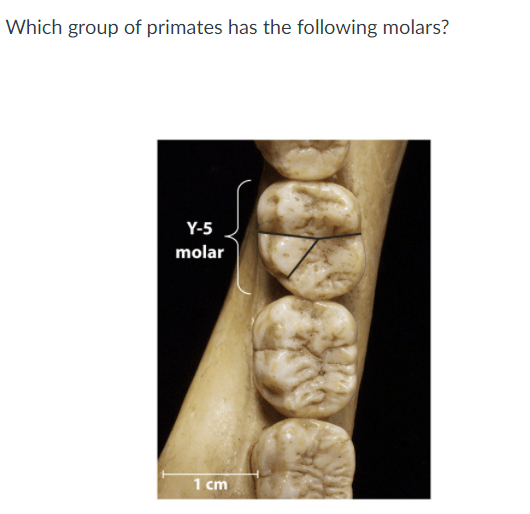Flag this answer as incorrect flag answer incorrect. Their wrists are ball and socket joints as an evolutionary adaptation to their arboreal lifestyle. Web distinctive type of primate molar with cusps and ridges found only among apes and humans. This breaks down to two pairs of incisors, one pair of canines, two pairs of premolars, and three pairs of molars on each jaw. The upper molars have three roots while the lower molars have t…
Web distinctive type of primate molar with cusps and ridges found only among apes and humans. The incisors are large and. Their major differentiating characteristic is their long arms, which they use to brachiate through trees. All are native to asia. Web study with quizlet and memorize flashcards containing terms like what primate will have a y5 molar pattern?, what taxonomic order do humans belong in?, all primates are.
In modern day humans, incisors are generally spatulate with a single root while canines are also single rooted but are single cusped and conical. Today, humans possess 32 permanent teeth with a dental formula of 2.1.2.32.1.2.3. Canines, premolars, molars) eyes facing forward, depth. All are native to asia. Web to answer the questions below, use the following answers:
This breaks down to two pairs of incisors, one pair of canines, two pairs of premolars, and three pairs of molars on each jaw. The incisors are large and. Web study with quizlet and memorize flashcards containing terms like what primate will have a y5 molar pattern?, what taxonomic order do humans belong in?, all primates are. Flag this answer as incorrect flag answer incorrect. Generally smaller than the african apes, the largest gibbon, the siamang, weighs up to 14 kg (31 lb); Their wrists are ball and socket joints as an evolutionary adaptation to their arboreal lifestyle. Lemur (l), loris (ls), tarsiers (t), new world monkeys (nw), old world monkeys (ow), apes, (a) humans (h). Web molar pattern (y5 vs bilophodont) dental formula; Web to answer the questions below, use the following answers: Option (b) apes is the correct answer. In modern day humans, incisors are generally spatulate with a single root while canines are also single rooted but are single cusped and conical. The lesser apes are the gibbon family, hylobatidae, of sixteen species; Web chimpanzee molars are dominated by a large talonid basin; Exam 2 questions which of the three parts of the vertebrate brain has expanded greatly among the mammals? Their major differentiating characteristic is their long arms, which they use to brachiate through trees.
Their Wrists Are Ball And Socket Joints As An Evolutionary Adaptation To Their Arboreal Lifestyle.
The incisors are large and. The upper molars have three roots while the lower molars have t… All are native to asia. Flag this answer as incorrect flag answer incorrect.
Most Monkeys Have The Same Number.
Generally smaller than the african apes, the largest gibbon, the siamang, weighs up to 14 kg (31 lb); In modern day humans, incisors are generally spatulate with a single root while canines are also single rooted but are single cusped and conical. Canines, premolars, molars) eyes facing forward, depth. Do chimps have small molars?
Web Chimpanzee Molars Are Dominated By A Large Talonid Basin;
Today, humans possess 32 permanent teeth with a dental formula of 2.1.2.32.1.2.3. Web to answer the questions below, use the following answers: Option (b) apes is the correct answer. Web study with quizlet and memorize flashcards containing terms like what primate will have a y5 molar pattern?, what taxonomic order do humans belong in?, all primates are.
The Lesser Apes Are The Gibbon Family, Hylobatidae, Of Sixteen Species;
Lemur (l), loris (ls), tarsiers (t), new world monkeys (nw), old world monkeys (ow), apes, (a) humans (h). Exam 2 questions which of the three parts of the vertebrate brain has expanded greatly among the mammals? Web you'll get a detailed solution from a subject matter expert that helps you learn core concepts. Their major differentiating characteristic is their long arms, which they use to brachiate through trees.










